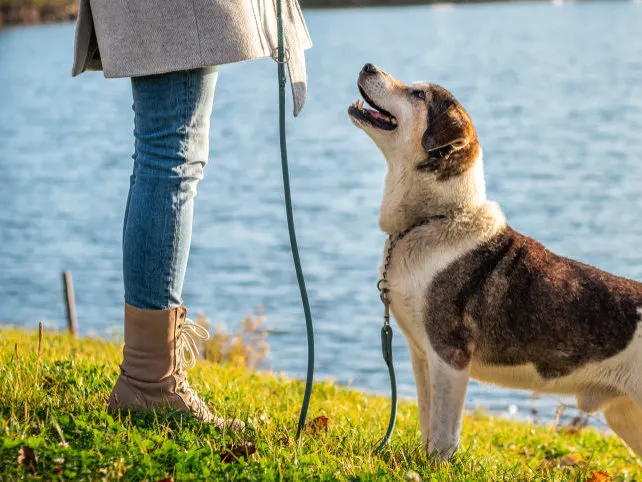How to Help Your New Best Friend Feel Safe, Secure, and Ready to Learn
Bringing an adopted dog home is one of life’s most rewarding experiences, but it can also be one of the most challenging. Many adopted dogs come from shelters, rescues, or uncertain pasts, and while they may be full of love, they also carry invisible baggage: fear, anxiety, confusion, or even mistrust.
At Alaska Dog Works, we’ve helped countless adopted dogs transform into confident, well-adjusted companions. Whether your new family member is a shy rescue from rural Alaska or a high-energy adolescent adopted from a shelter, the goal is the same, to build trust first, then train.
Because when a dog feels safe and connected to their person, training becomes communication, not control.
Why Trust Is the Foundation of Every Training Plan
Before you can teach an adopted dog to sit, stay, or walk politely, you must first teach them that you’re worth trusting.
Dogs are deeply relational animals. They read our tone, our body language, and our consistency. For adopted dogs, especially those who have experienced instability, trust doesn’t come automatically. It has to be earned.
At Alaska Dog Works, we call this relationship-first training. It’s the same philosophy we use in our Lead Dog Service Dog Training Program and DAWGS Therapy Dog Program, because confidence and calmness can’t be commanded, they must be built.
When a dog trusts you:
Their stress levels drop.
They become more open to learning.
They start to look to you for guidance instead of reacting out of fear or uncertainty.
Trust isn’t built through dominance or control, it’s built through safety, predictability, and clear communication.
The First 72 Hours: Give Them Space to Decompress
When you bring an adopted dog home, the first three days are critical. Everything is new, the sights, smells, people, and routines. Even a well-socialized dog can feel overwhelmed.
Create a Safe, Quiet Space
Set up a designated area where your dog can relax undisturbed. This could be a crate with a cozy bed, a quiet room, or a calm corner of your home. Let them approach new experiences at their own pace.
Avoid Overexposure
It’s tempting to introduce your dog to friends, neighbors, or other pets right away, but too much too soon can backfire. Start with calm, structured experiences.
Stick to a Routine
Dogs find comfort in predictability. Feeding, walking, and bedtime routines help them feel safe and grounded.
Remember: in these early days, your goal isn’t training, it’s reassurance.
Understanding Your Dog’s Behavior
Many adopted dogs display behaviors rooted in fear, confusion, or lack of prior training. Barking, hiding, pacing, or even minor aggression can all be signs of stress, not defiance.
Here’s what to look for and how to respond:
Cowering or Avoidance → Give space and use calm, soft tones. Avoid reaching over their head; instead, sit or kneel to appear less intimidating.
Excessive Barking or Whining → This may signal anxiety. Establish structure and clear boundaries rather than punishment.
Leash Pulling or Reactivity → Adopted dogs may not have had positive leash experiences. Start slow, in low-distraction areas, and reward calm walking.
Potty Accidents → Even house-trained dogs can regress under stress. Re-establish a schedule and praise successful potty breaks outside.
Every behavior tells a story. Listen to it before you try to correct it.
Positive Reinforcement: The Key to Building Confidence
Once your dog feels safe, you can begin formal training. The most effective and humane method, especially for adopted dogs, is positive reinforcement.
This approach focuses on rewarding desired behaviors rather than punishing unwanted ones. When your dog sits, walks nicely, or looks at you calmly, reward them immediately with treats, praise, or affection.
At Alaska Dog Works, we’ve found that positive reinforcement:
Rebuilds a dog’s confidence
Encourages problem-solving
Creates lasting behavioral change
Deepens the human-canine bond
When your adopted dog learns that good things happen when they make good choices, training transforms from stressful to empowering.
Training Tips for Adopted Dogs: Step by Step
Here’s how to set your new dog up for success, whether you’re working toward a peaceful household or preparing for therapy or service work.
1. Start with Short, Positive Sessions
Keep training sessions brief, just 5 to 10 minutes at a time, and focus on one behavior at a time. End on a success, even if it’s small. Confidence is built through repetition and reward.
Pro Tip: If your dog struggles to focus, train right before mealtime when motivation is higher.
2. Teach Their Name and Attention First
If your adopted dog doesn’t respond to their name, that’s your first lesson. Say their name in a calm, happy tone and reward them the moment they make eye contact.
Eye contact builds connection, it’s your bridge to every other skill.
3. Practice “Calm Presence” Exercises
For nervous or reactive dogs, calmness is a skill. Practice simply sitting quietly with your dog in new environments, your yard, a park, or a trailhead, and reward relaxed body language. This builds emotional resilience and teaches them that new places don’t equal danger.
4. Introduce the Leash Slowly
Many adopted dogs associate leashes with stress. Start by letting your dog wear the leash indoors without tension. Reward calm behavior and avoid dragging or pulling. Gradually introduce structured walks once they’re comfortable.
At Alaska Dog Works, we often use “engagement walks,” where the focus isn’t distance, but connection. Every few steps, we reward the dog for checking in with their handler. It’s about partnership, not perfection.
5. Use Food Wisely
High-value treats, like chicken, cheese, or freeze-dried liver, work wonders for building trust. Feed from your hand during early bonding sessions. This teaches your dog that you’re the source of good things and helps overcome fear or hesitancy.
6. Avoid Harsh Corrections
For dogs with unknown or difficult histories, physical or verbal corrections can quickly erode trust. Avoid yelling, leash popping, or intimidating body language. If a behavior needs to change, focus on redirecting rather than punishing.
Example: Instead of yelling “No!” when your dog jumps, calmly turn away and reward them when all four paws are on the floor.
7. Gradually Introduce New People and Pets
Socialization is important, but it should be done thoughtfully. Pair introductions with rewards, allow your dog to retreat if needed, and always supervise early interactions. Confidence grows through controlled success, not forced exposure.
Addressing Common Challenges
Adopted dogs often exhibit behaviors that require patience and consistency. Here are some common issues we address in our Alaska Dog Works programs:
Leash Reactivity
If your dog barks or lunges at other dogs, it’s likely rooted in fear or frustration. Our trainers use controlled setups and reward-based redirection to teach calm focus and neutrality.
Separation Anxiety
Dogs who have been rehomed or abandoned may panic when left alone. We gradually desensitize them to your departures, building comfort with independence.
Resource Guarding
Some rescues guard food, toys, or space due to scarcity in their past. We use trust-based exercises to teach that humans approaching means more good things, not loss.
Overexcitement or Lack of Boundaries
Adopted adolescent dogs can act like wild teenagers, jumping, nipping, or ignoring cues. Structure, consistency, and proper outlets for energy help turn chaos into cooperation.
Real Success Story: From Fearful to Fearless
One of our clients adopted a two-year-old Husky mix named Tundra from a local rescue. Tundra had spent most of his life outdoors with minimal human contact. He was terrified of leashes, cars, and even household noises.
Using gentle, reward-based methods, we helped Tundra’s new owner teach him to walk calmly on a leash, relax around new people, and build confidence through routine and structure. Within months, he went from hiding behind furniture to joining his family on hikes and camping trips.
Tundra’s story is proof: with patience, trust, and the right training plan, even the most fearful dogs can thrive.
Why Adopted Dogs Thrive in Alaska Dog Works Programs
At Alaska Dog Works, we specialize in helping dogs transition from uncertainty to reliability. Our training isn’t about quick fixes, it’s about long-term partnerships.
Here’s what makes our approach different:
Relationship-Based Philosophy: We train both ends of the leash, dog and human, so communication becomes second nature.
Customized Training Plans: No two rescue dogs are alike. We design a step-by-step plan based on your dog’s temperament, history, and goals.
Real-World Proofing: Whether it’s calm behavior on the Anchorage trails or confident travel in urban environments, we train for real life, not just obedience drills.
Ongoing Support: Through our Peak Performance Membership, clients receive continued coaching and community, ensuring your dog’s progress lasts for life.
The Role of Patience and Perspective
It’s easy to feel frustrated when your adopted dog doesn’t “get it” right away, but remember, they’re not being stubborn; they’re learning a whole new language. Every success, no matter how small, is a milestone.
Patience isn’t just a virtue in dog training, it’s a tool. By giving your adopted dog time to decompress, learn, and trust, you’ll see transformation happen faster than you think.
As we tell our clients: slow is smooth, and smooth becomes fast.
Call to Action
If you’ve recently adopted a dog, or are planning to, our team at Alaska Dog Works is here to help. We’ll create a customized plan to help your dog build trust, confidence, and lasting obedience.
Whether your goal is a calm companion, a therapy dog, or even service dog training, we’ll guide you every step of the way.
👉 Call 206-752-DOGS or visit AlaskaDogWorks.com to schedule your strategy call today and start your adopted dog’s journey toward confidence and calm.










